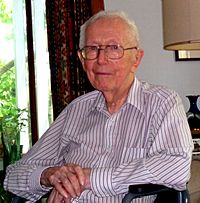Charles Duncan Michener facts for kids
Quick facts for kids
Charles Duncan Michener
|
|
|---|---|

Charles D. Michener at home, 2015
|
|
| Born | September 22, 1918 |
| Died | November 1, 2015 (aged 97) |
| Nationality | American |
| Alma mater | University of California, Berkeley |
| Scientific career | |
| Fields | Entomology, melittology |
| Institutions | University of Kansas |
| Thesis | Comparative External Morphology, Phylogeny, and a Classification of the Bees (1942) |
| Doctoral advisor | Edward Oliver Essig |
| Doctoral students | Edward M. Barrows, Paul R. Ehrlich |
Charles Duncan Michener (born September 22, 1918 – died November 1, 2015) was an American scientist. He was born in Pasadena, California. He was a top expert on bees. His most important work was a book called The Bees of the World, published in 2000.
Contents
Life and Work of Charles Michener
Charles Michener spent most of his career studying bees. He focused on how bees are classified and how they live in nature. He published his first scientific paper when he was just 16 years old in 1934.
He earned his first degree in 1939. Then, he got his PhD in entomology (the study of insects) in 1941. Both degrees were from the University of California, Berkeley. He stayed in California until 1942. After that, he became an assistant curator at the American Museum of Natural History in New York City. There, he worked with Lepidoptera, which are butterflies and moths.
Bee Classification and Military Service
In 1944, Charles Michener created a new way to classify bees. This system was quickly used by scientists all over the world. He later helped update these classifications in 1993 and 1995.
From 1943 to 1946, Michener also served in the United States Army. He was a first lieutenant and then a captain. During this time, he researched diseases spread by insects. He also studied the life cycle of the common chigger, a tiny mite.
Joining the University of Kansas
Michener joined the University of Kansas in 1948. He became an associate professor of entomology. He led the Entomology Department from 1949 to 1961. He also led it again from 1972 to 1975.
He received many important awards and honors. He won a Guggenheim Fellowship twice, in 1955 and 1966. In 1958, he became a Watkins Distinguished Professor of Entomology. He also received a Fulbright Scholarship to Australia in 1958.
In 1965, he was chosen to be part of the National Academy of Sciences. This is a very respected group of scientists in the United States. In 1974, he became the director of the Snow Entomological Museum. This museum is now part of the University of Kansas Natural History Museum.
The Bees of the World Book
In February 2001, Michener's big book, The Bees of the World, won a major award. The Association of American Publishers gave it the R.R. Hawkins Award. This award is for the best professional or scholarly work of the year 2000.
Michener's studies on how social behavior developed in Halictidae bees were very important. These studies helped set the stage for new ideas about how animals become social. This included the work of scientist E. O. Wilson. Wilson used Michener's ideas about how bees changed from living alone to living in highly social groups.
Leadership and Teaching
Besides his research and teaching, Michener was also an editor for several science journals. He edited Evolution from 1962 to 1964. He was also an editor for the Annual Review of Ecology and Systematics and Insectes Sociaux.
He served as president for many scientific groups. These included the Kansas Entomological Society and the Society for the Study of Evolution. He was also president of the American Society of Naturalists. In 1977, he became president of the International Union for the Study of Social Insects. He even organized a big international meeting in 1982. He is also an honorary member of the Brazilian Academy of Sciences.
When he retired in 1989, Michener had already published over 340 articles and books. Most of these were about how bees are classified and how they live. A special fund was started at the University of Kansas to create a lecture series in his name. He continued to publish new research until 2015.
Michener also trained many students during his long career. More than 80 students earned their master's or doctoral degrees under his guidance. Some of his notable students include Edward M. Barrows and Paul R. Ehrlich.
See also
 In Spanish: Charles Duncan Michener para niños
In Spanish: Charles Duncan Michener para niños

